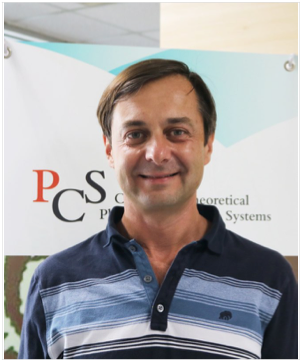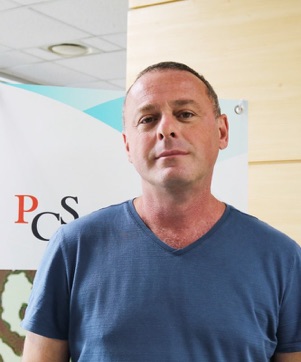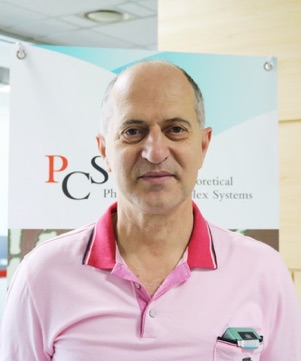





(University of Hamburg, Germany)
at PCS: Aug. 28 - Sep. 27, 2017
Alexander Chudnovskiy

Research interests: correlations in mesoscopic and low-dimensional electron systems under equilibrium and out of equilibrium conditions; topological insulators; phase diagram in spinor quantum gases; dynamics of magnetization and magnetic correlations.
I am using analytical, mostly field-theoretical methods of investigation of many-particle strongly correlated systems, such as electron systems in solid state nanostructures and spinor quantum gases, searching for exotic quantum and thermodynamical phases in those systems, either at equilibrium or under nonequilibrium driving. My current research is focused on two problems: the role of interactions in topological insulators, and exotic quantum phases in low-dimensional spinor atomic gases.
Most important publications:
[1] A.W. Holleitner, A. Chudnovskiy, D. Pfannkuche, K. Eberl, R.H. Blick, Pseudospin Kondo correlations versus hybridized molecular states in double quantum dots, Phys. Rev. B 70, 075204 (2004).
[2] A.L. Chudnovskiy, D. Pfannkuche, Influence of disorder on ferromagnetism in diluted magnetic semiconductors, Phys. Rev. B 65, 165216 (2002).
[3] A.L. Chudnovskiy, J. Swiebodzinski, A. Kamenev, Spin-torque shot noise in magnetic tunnel junctions, Phys. Rev. Lett. 101, 066601 (2008).
[4] A.L. Chudnovskiy, D.M. Gangardt, A. Kamenev, Doublon relaxation in the Bose-Hubbard model, Phys. Rev. Lett. 108, 085302 (2012).
[5] A.L. Chudnovskiy, S.E. Ulloa, Kondo and mixed-valence regimes in multilevel quantum dots, Phys. Rev. B 63, 165316 (2001).
(Shamoon College of Engineering, Israel)
at PCS: Aug. 25 - Sep. 26, 2017
Victor Kagalovsky
In my research I study various applications of the network models, starting with the original Chalker-Coddington (CC) network model, proposed to describe inter-plateaux transition in the integer quantum Hall effect (QHE) and based on its semi-classical picture. Different symmetries of the transfer matrices corresponding to novel symmetry classes allow to study the spin QHE and thermal QHE, as well as quantum spin Hall effect with very nontrivial phase diagram. Two recently introduced network models: a weakly chiral network model on the square lattices, and a triangular network model, describe levitation of extended states at low magnetic fields. To study the effect of magnetic impurities on QHE the exact analytical expression for spin-dependent transmission coefficients is found. A fictitious nonunitary scattering matrix S is introduced for electrons, reproducing the exactly calculated scattering probabilities, with decoherence identified by the deviation of S from unitarity. My research is also devoted to phenomenological description of topological insulators, two of its main results are the explanation of the experiment with asymmetric current electrodes and prediction of new quantum Hall effects in systems with ferromagnetic electrodes. My most recent research studies a sliding Luttinger liquid to model metal-insulator transition and to study edge states in topological insulators.
I organized conferences in Dresden, Trieste, Loughborough, UK, and Pohang, South Korea. Last year together with German and US collaborators we have organized the program “Recent progress and perspectives in topological

(Loughborough University, UK)
at PCS: Aug. 28 - Sep. 27, 2017
Fedor Kusmartsev
Current topics of research include: Nanoscience and Nanotechnology, Nanophysics, Magnetic materials, Metamaterials, Topological Insulators and Weyl semimetals, Quantum Computing, Quantum Field Theory Methods.
Did a lot of original work in theories of condensed matter physics, especially in topological insulator, superconductivity and quantum computing.
Published in high profile journals (NATURE, Nano Letters, Nanoscale, Physical Review Letters, Physical Review and others) - more than 250 papers. Including 2 in Nature communications, 15 in Physical review letters, 5 in Nanoscales. The publications have over 3000 citations.
Has been leading and managing the large multi-stakeholder research consortium – the European Network-Programme “Arrays of Quantum Dots and Josephson Junctions”(AQDJJ) from 2004, which includes 75 universities from 12 EU countries. The European Science Foundation assessment reports unanimously stated that the strong success of the AQDJJ consortium work was “due to the leadership of the AQDJJ chairman, Prof F V Kusmartsev.”
Elected as Fellow of British Institute of Physics in 1999.
Elected as Fellow of American Physical Society in 2014.
Boarding member of Scientific Report: Nature.

(Aston University, UK)
at PCS: Aug. 25 - Sep. 26, 2017
Igor Yurkevich
He has worked in the area of disordered physics for the past twenty years. His main research has focused on the study of quantum coherence at microscopic and macroscopic levels. He has investigated transport and localisation of surface polaritons [1], localisation of waveguide modes [2], and superconductivity in disordered interacting systems [3,4]. He has published over 80 papers, attracting over 1200 citations. His main research interests over the last decade have focused on strongly correlated quantum and classical systems which are disordered [5,6] and nonlinear [7]. As an example of the latter, he devised an approach to the nonperturbative calculation of information transmission rate in fibres [7] where noise and nonlinearity are inherently part of the problem. For the former, he worked out functional bosonisation techniques [5] for the description of the Luttinger Liquid, later applied to the calculation of electron transport through an isolated impurity in the LL [8] and scaling dimensions of perturbations in multi-component strongly correlated liquids [9,10]. Recently, his main interest has shifted towards one-dimensional strongly correlated bosonic systems. He is working on the application of field-theoretic techniques for the propagation of high-intensity light in nonlinear media [11] and out-of-equilibrium systems tested by pump-probe techniques [12,13]. These techniques, in particular, and his extensive experience in low-dimensional quantum systems, in general, would underpin the theoretical part of the research project.

insulators: quantum Hall effects, ballistic vs. diffusive regimes and Anderson transitions” at Kavli Institute for Theoretical Physics, China in April, 2016. I have also been a Convener of the Advanced Study Group (August 24 - September 21, 2016) and Coordinator of the Workshop “Anderson Localization in Topological Insulators” at the Center for Theoretical Physics of Complex Systems, Institute for Basic Science, Daejeon, South Korea (September 5 – 9, 2016).
[1] A.A. Maradudin, J.A.Sanchez-Gil, Jun Q. Lu, V. Freilikher, M. Pustilnik and I.V. Yurkevich, PRB 50, 15353 (1994).
[2] J. Sanchez-Gil, V. Freilikher, I.V. Yurkevich and A. Maradudin, PRL 80, 948 (1998).
[3] I.V. Yurkevich and I.V. Lerner, PRB 64, 054515 (2001).
[4] I.V. Yurkevich and I.V. Lerner, PRB 63, 064522 (2001).
[5] I.V. Yurkevich, Field Theory of Strongly Correlated Fermions and Bosons in Low-Dimensional Disordered Systems, ed. by Lerner et al., Kluwer Academic Plenum Publishers, 72, 69 (2002).
[6] A. Grishin, I.V. Yurkevich and I.V. Lerner, PRB 69, 165108 (2004).
[7] K.S. Turitsyn, S.A. Derevyanko, I.V. Yurkevich, S.K. Turitsyn, PRL 91, 203901 (2003).
[8] I.V. Lerner, V.I. Yudson, I.V. Yurkevich, PRL 100, 256805 (2008).
[9] A. Galda, I.V. Yurkevich, I.V. Lerner, PRB 83, 041106(R) (2011).
[10] I.V. Yurkevich, EPL 104, 37004 (2013).
[11] K.A. Ralley, I.V. Lerner, and I.V. Yurkevich, Sci. Rep. 5, 13947 (2015).
[12] W. He, A. Zakar, T. Roger, I.V. Yurkevich, and A. Kaplan. Opt. Lett. 40 (16), 3889 (2015).
[13] W. He, I.V. Yurkevich, L.T. Canham, A. Loni, and A. Kaplan, Opt. Expr., 22, 27123 (2014).